Your home is somewhere you expect to feel safe. Yet more injuries and deaths from fire occur in the home than in any other place. In fact, the U.S. Fire Administration reported deaths from residential fires increased in 2018. Aging adults are at a greater risk of fire death than the general public.
Don’t underestimate the danger of fire. Use this home fire safety guide to help you prepare and learn what to do if a fire breaks out in your home.
Home Fire Safety and Prevention by Fire Type
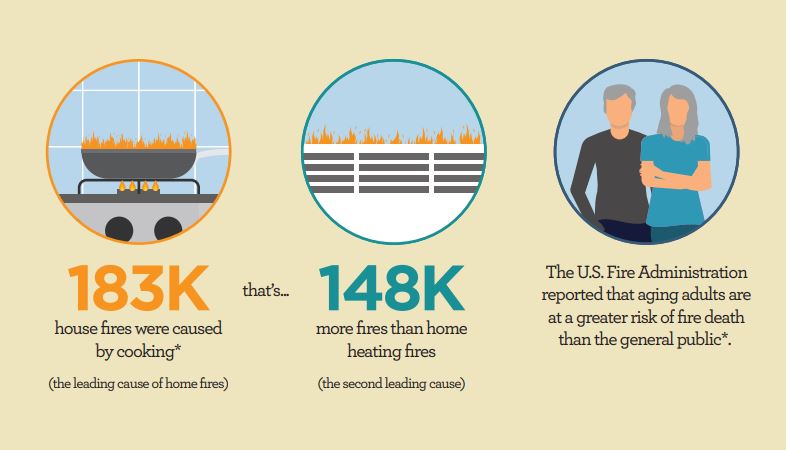 Click on the image to see full the infographic with more fire safety tips.
Click on the image to see full the infographic with more fire safety tips.
Cooking Fires
Cooking fires are the leading cause of home fires and injuries. Here are home fire prevention tips you can do to decrease the chance of a cooking fire:
- Never leave the stovetop unattended.
- Electrical Stoves: Use a burner that is the right size for the pan. A burner that is too large can cause the pan and its contents to heat too quickly, which can lead to boil-overs, scorching and burning.
- Gas Stoves: Keep the flame entirely under the pan. A flame that surrounds the pan can easily ignite a loose-fitting sleeve.
- Keep the stovetop, oven and range hood free of grease and spills that can catch on fire.
Electrical Fires
Home electrical fires can occur if wires are installed incorrectly or if circuits are overloaded.
Warning signs include:
- Flickering or dimming lights
- Switches or outlets that are hot to the touch
- Switches or outlets that emit a pungent odor
- Discolored cords, outlets and switch plates
- Repeated blown fuses or tripped circuit breakers
Here’s how you can protect yourself from starting an electrical fire:
- Hire a qualified, licensed electrician to inspect your home and make any necessary repairs.
- Replace fuses or circuit breakers with the correct size.
- Don’t run cords under carpeting, bedding or other combustible materials. Don’t run cords across a frequently traveled area.
- Discard frayed or broken cords and never splice two cords together.
- Use the right wattage for lamps and fixtures.
- Position lamps away from open windows, where strong breezes can blow draperies onto hot light bulbs.
Furniture Fires
Furniture can play a large role in how quickly a fire spreads. That’s because the foam and fillers burn rapidly, release tremendous heat, produce toxic gases and consume oxygen rapidly.
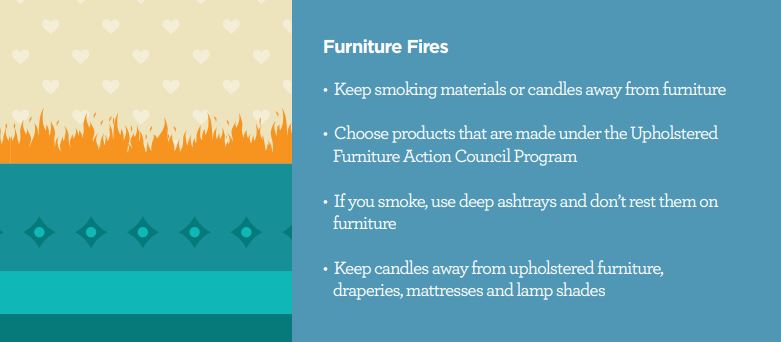 Click on the image to see full the infographic with more fire safety tips.
Click on the image to see full the infographic with more fire safety tips.
Here are a few home fire safety tips to be aware of when choosing new furniture for your house:
- Choose fire-resistant furniture: Look for furniture approved by the Upholstered Furniture Action Council or that meets the requirements of the California Bureau of Home Furnishings.
- Replace your old mattress. Mattresses manufactured after 1973 are required to be more resistant to ignition by cigarettes.
- Keep electrical cords, lamps and appliances away from upholstered furniture and mattresses.
Home Fire Safety Tips for Home Heating System Fires
Fireplaces, wood or pellet stoves, and other fuel-fired appliances are often used as an alternative way to heat your house. But the improper use of these other heating methods is a leading cause of house fires in December, January and February.
If you’re planning to use another method to keep warm in your house, here are home fire safety tips to keep in mind:
- Allow 3 feet of open space on all sides of space heaters, wood stoves and fireplaces.
- Refuel a heater only when it is cool. When refueling, make sure it’s away from any open flames, such as candles or lit cigarettes.
- If you’re using a portable heater, choose a model with a “tip switch.” This will automatically shut off the unit if it is tipped over.
- Be sure your wood or pellet stove is properly installed and up to code.
- Have wood stoves, fireplaces and chimneys inspected annually and regularly cleaned.
- Use a fire screen or fireplace doors to contain sparks.
- Clean your fireplace. Never allow more than one inch of buildup of soot or ash.
- Have your chimney inspected every year, even if you have a gas fireplace.
- Have a professional install a safety pilot on gas fireplaces.
Candle Fires
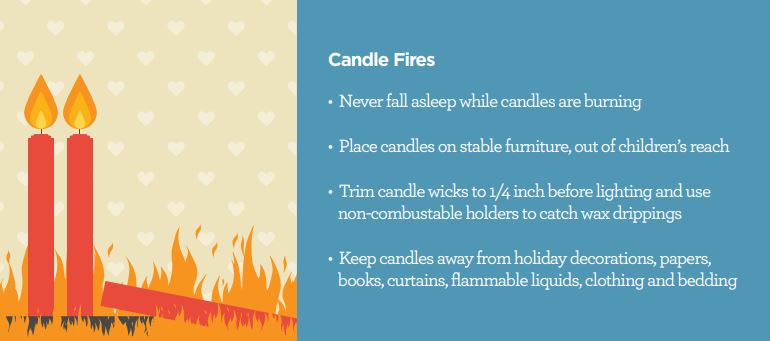 Click on the image to see full the infographic with more fire safety tips.
Click on the image to see full the infographic with more fire safety tips.
Whether you’re using candles in your home during a power outage or to emit a fragrance, it’s important to stay responsible. If you’re using a candle, keep this in mind:
- Place candles on stable furniture where children and pets can’t knock them over.
- Never fall asleep while candles are burning.
- Trim candlewicks to ¼ inch before lighting and use non-combustible holders to catch wax drippings.
- Extinguish candles when you leave a room or when the candles burn within two inches of their holders.
- Keep candles away from holiday decorations, papers, books, curtains, blinds, lampshades, flammable liquids, clothing and bedding.
- Consider replacing regular burning candles with battery-operated versions to provide ambiance.
Home Fire Safety and Seasonal Fires
The holidays may mean more time with your family, but it can also present unique fire hazards. Here are home fire prevention things you can do to reduce the risk of a fire during the holidays and all year long:
- Stay in the kitchen when you have something cooking on the stovetop or in the oven.
- Replace any faulty products before use.
- Keep decorations away from candles, fireplaces and other sources of heat.
- Don’t use products intended for outdoor use only inside your home.
- Use outdoor lights responsibly. Keep extension cords and lights away from snow or standing water to avoid damage. When installing lights, use a ladder made of wood or fiberglass because metal ladders can conduct electricity.
- Keep matches and lighters away from children.
- Check local laws about using fireworks and follow all regulations. Never allow children to use them unsupervised.
Smoking Fires
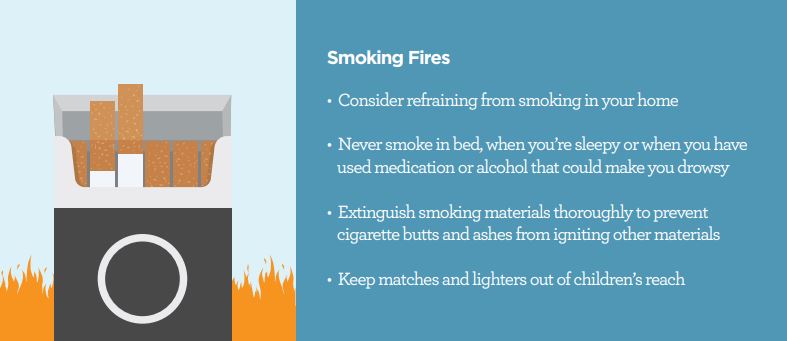 Click on the image to see full the infographic with more fire safety tips.
Click on the image to see full the infographic with more fire safety tips.
Improperly discarded cigarettes or irresponsible smoking can result in a potentially deadly home fire. If you’re a smoker, keep these home fire safety items in mind to reduce your risk of a home fire:
- Consider quitting smoking or refraining from smoking in your home.
- Never smoke in bed, when you’re sleepy, or when you have used medications or alcohol that could make you drowsy.
- Extinguish smoking materials thoroughly to prevent cigarette butts and ashes from igniting other materials. You can do this by dousing the materials underwater.
- Use child-resistant lighters. Keep matches and lighters out of the reach of children.
Wildfires
Wildfires are incredibly dangerous and destructive. Your best option is to prepare your property to mitigate damage and evacuate. If you live in an area susceptible to wildfires consider making the following modifications to your property.
Property within 30 Feet of Your Home
- Get rid of combustible materials such as dried leaves.
- Cut down any tree limbs that are 15 feet or closer to the ground.
- Remove vines or vegetation that are growing into your house.
Property within 100 to 30 Feet from Your Home
- Use gravel pathways or driveways to create “fuel breaks” across your property.
- Cut tree branches that are three feet or closer to the ground.
- Get rid of combustible materials.
Property within 200 to 100 Feet from Your Home
- Plant trees far enough apart that the branches do not touch.
- Place firewood or scrap wood at this distance from home.
- Get rid of combustible materials.
Home Fire Safety & Prevention Tips
It’s too late to plan what to do when a fire strikes. In 30 seconds, a small flame can quickly grow out of control. To keep you and your home safe, it’s best to prepare, develop a home fire safety plan early and discuss what to do if a fire breaks out in your home.
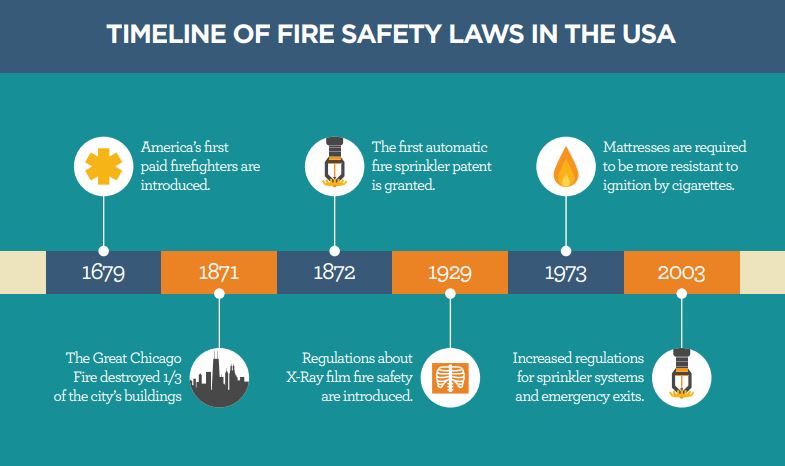 Click on the image to see full the infographic with more fire safety tips.
Click on the image to see full the infographic with more fire safety tips.
Smoke Alarms
Be sure to place working smoke alarms in your home. This is a top method for home fire prevention. Install smoke alarms:
- Outside of every bedroom
- Inside of every bedroom with a closed door
- On every story in the house
- In the basement
Place wall-mounted smoke alarms 4 to 12 inches from the ceiling. The ceiling-mounted smoke alarms should be placed at least 4 inches from the nearest wall.
To keep smoke alarms working properly:
- Clean smoke alarms regularly by vacuuming them with a brush attachment.
- Be vigilant about testing your alarms every month.
- Replace the batteries every six months – Daylight Saving Time is a good time to remember to do this.
- Buy new alarms every 10 years.
- Always keep batteries in your smoke alarms; never remove them except to replace them with fresh batteries.
- Purchase smoke alarms meeting the national standards developed by Underwriters Laboratories.
Home Sprinkler Systems
Ninety percent of fires are contained by the operation of just one sprinkler.
Consider installing sprinklers in high-risk areas such as the kitchen. Home sprinkler systems provide significant protection for your family and property. They are designed so that only the sprinkler closest to the fire will activate, spraying water directly on the fire.
Fire Extinguishers
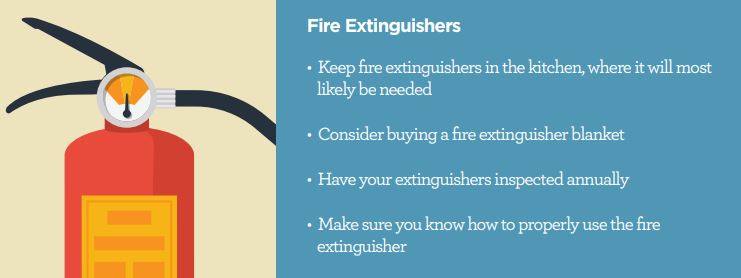 Click on the image to see full the infographic with more fire safety tips.
Click on the image to see full the infographic with more fire safety tips.
Having easy access to a fire extinguisher can significantly reduce the chance a fire spreads in your home. Consider putting a fire extinguisher in the kitchen and anywhere else you could easily access it.
Addressing Different Types of Fires
Generally, you can try to put out a fire with water or a fire extinguisher. But with some types of fires, this can put you in more danger.
- Electrical Fires: Don’t put water on an electrical fire. You risk the chance of electrocution by doing this. Instead, turn off the power to the electrical system and use a fire extinguisher.
- Grease Fires: Put a lid on the pan or toss baking soda on the flames. Don’t use water or a fire extinguisher because this can cause the oil to splatter and spread the fire even quicker.
Have a Fire Safety Plan for Home
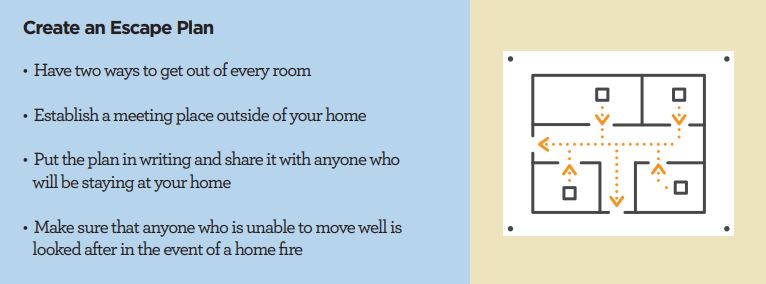 Click on the image to see full the infographic with more fire safety tips.
Click on the image to see full the infographic with more fire safety tips.
Whether you are living in an apartment building, or your own home, you want to have a fire safety plan for home and an escape plan in place before a fire. With practice, your home fire escape plan can become second nature for almost everyone. Follow these guidelines when creating your evacuation plan:
- Plan two ways out of every room.
- Establish a meeting place outside.
- Write your home fire safety plan down.
- Have family members practice your escape plan with fire drills.
Teach Children the Importance of Fire Safety at Home
Of all the lessons you’ll teach the children in your family, fire safety is the one that may save their lives or yours. That’s why The Hartford created this fun, educational program that children can complete at home at their own pace. Our Junior Fire Marshal program takes life-saving lessons and makes them fun for kids. Spend some time learning with the little ones in your life, or share the program with friends and family.

Safeguard Your Home with Homeowners Insurance
Fire can be incredibly destructive, but that doesn’t mean you can’t prepare yourself. By taking the right steps (which includes having enough homeowners insurance), you can help safeguard yourself, your family and your home.